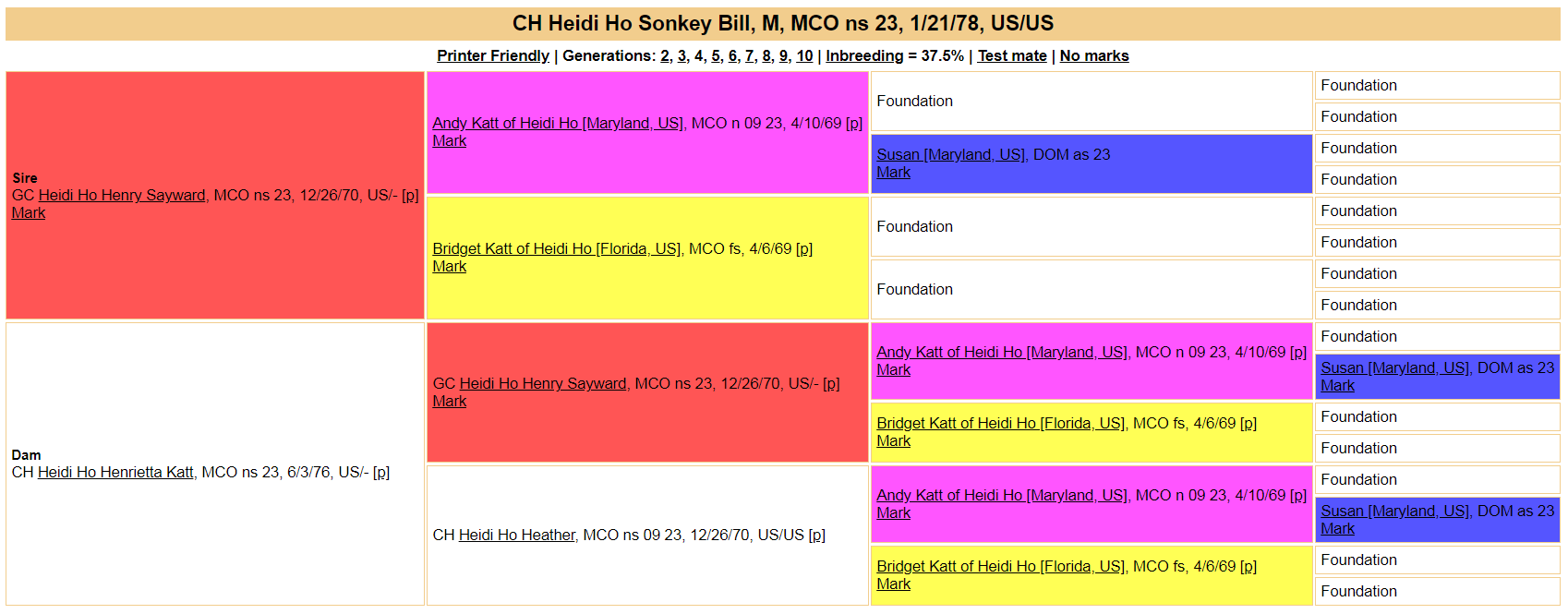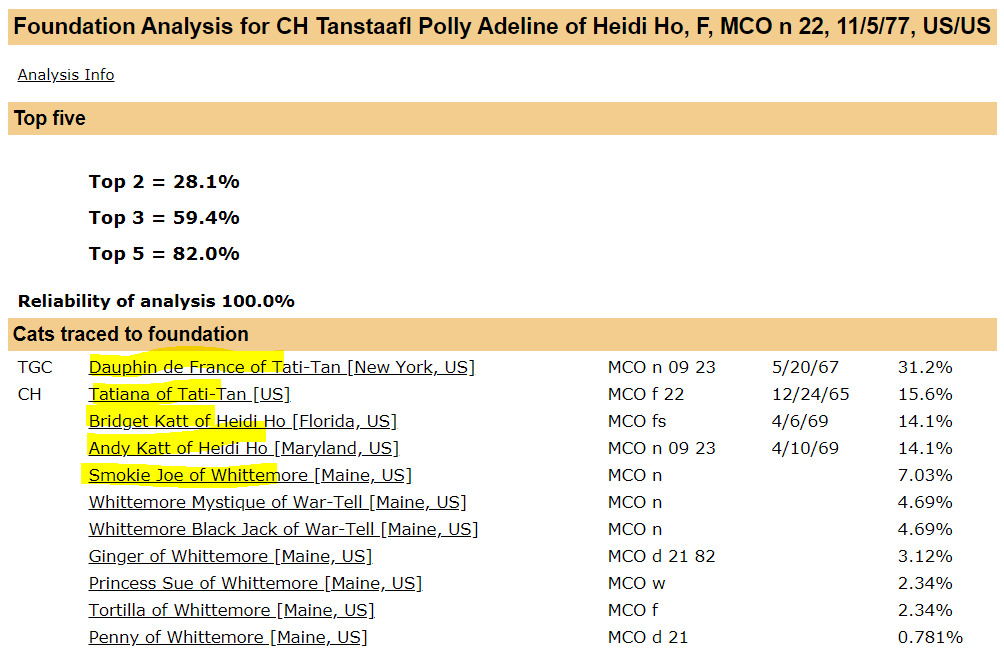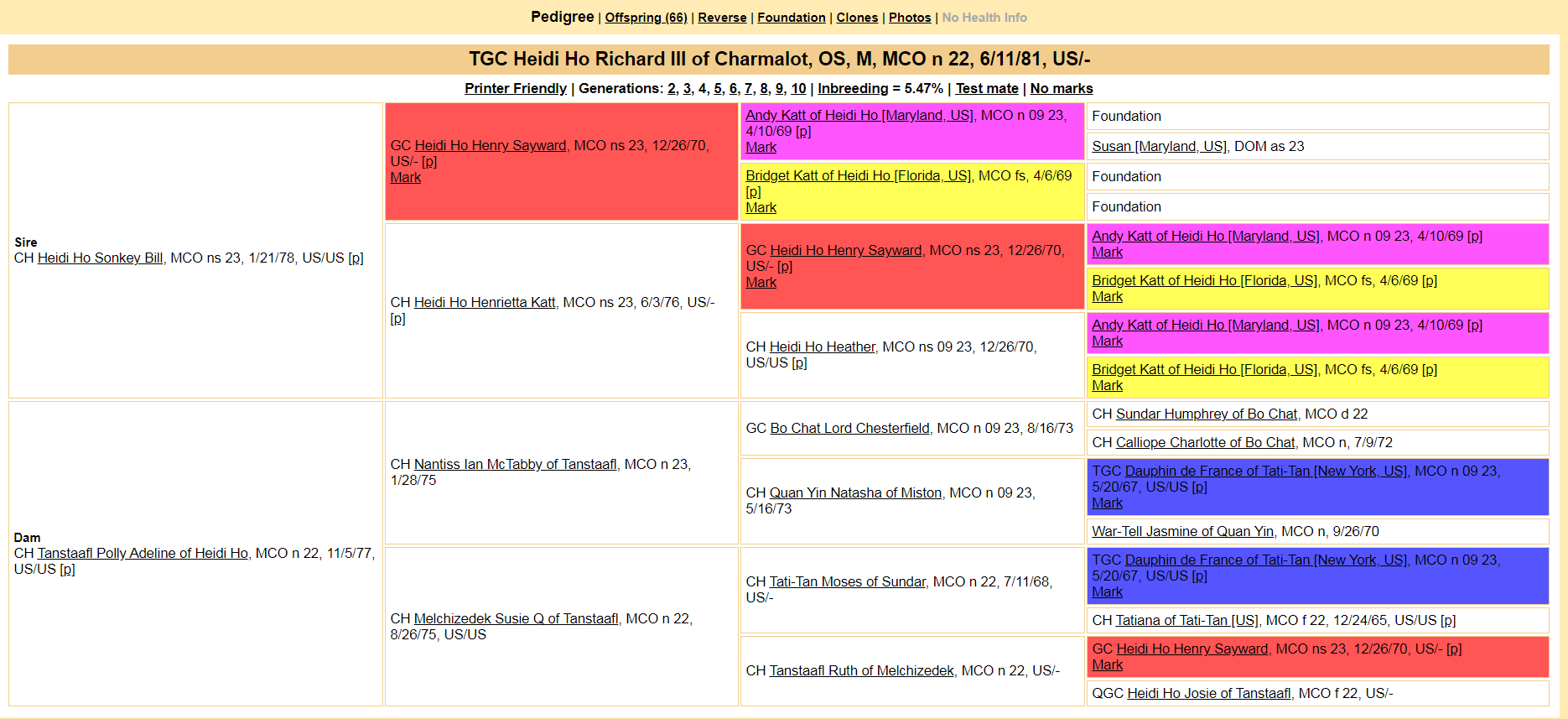Within the Maine Coon breed we talk about the clones or the clones percentage. But what is meant by this exactly?
When talking about the clones, we are talking about the 17 descendants of Tanstaafl Polly Adeline or Heidi Ho (Polly) and Heidi Ho Sonkey Bill (Sonkey) born between 1979 and 1982. The reason that they were given the name "clones" is because the kittens looked exactly the same. Just as if they were copies of each other, painted with a different color. These comments were also made when the breeder presented her first litter at a show. Because of this the label "the clones" has remained. Both parents got champion titles added to their names and their first growing kittens did very well on show also. This made the clones in the early 1980's very popular. The similar look of the kittens was very desirable at the time, because the predictability of future good showresults made them very attractive for other breeders. Sonkey and Polly together had 7 litters. From these litters, 17 kittens were used into breedingprograms. Below you can see a screenshot from Pawpeds of the clones. The first colums shows that many of them have indeed obtained their showtitles.
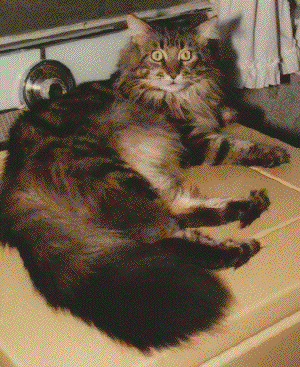
Many of these 17 clone brothers and sisters can still be found in the pedigree of the Maine Coon of today. Nowadays a Maine Coon has a clones percentage of 35% on average. This means that 35% of the pedigree of this cat consists of the clones from 40 years ago. Sometimes the clones can be found more than 70 times in the family tree.
Sonkey - the father of the clones
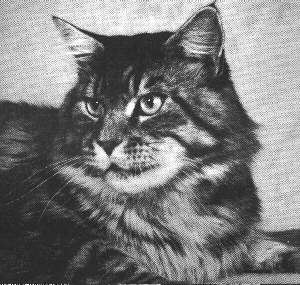
Two children of Andy and Bridget were mated (Henri Sayward and Heather, brother and sister). A daughter of that combination, Henrietta, is again paired with her father (Henri Sayward). Sonkey was born as a result. Sonkey's father is also his grandfather and Sonkey's grandmother is also his aunt. Andy and Bridget are both his grandfather and grandmother on father's side, and twice his great-grandfather and great-grandmother on mother's side. Sonkey therefore has an extremely high total inbreeding coefficient of 37.5%.
Sonkey had 42 offspring (including the 17 clones). Sonkey also became a grandfather of 404 grandchildren, of which 225 related to the clones. The other 179 grandchildren of Sonkey are from female partners other then Polly. Those 179 offspring obviously have a clones percentage of 0%.
In his pedigree you can see the double ancestors in the same color. This is a pedigree that most breeders will avoid at all times. Still, Sonkey and his clones are found in almost all of the Maine Coon family trees today. Can you imagine that when a cat that has 35% in clones, the pedigree consists for 17,5% of father Sonkey, who is the result of a father - daughter mating, where the daughter is the result of a brother - sister mating. It makes you wonder...
Polly - the mother of the clones
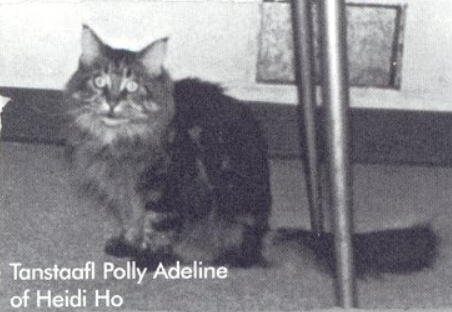
Polly's (Tanstaafl Polly Adeline or Heidi Ho) pedigree consists of fewer inbreeding matings than those of her partner Sonkey. Her total inbreeding percentage is 7.81%. Half of her mother's line consists of Andy and Bridget. But Polly's pedigree also contains the three other foundation cats, which together with Andy and Bridget form the top 5 most common foundation cats. Polly's pedigree consists of Dauphin de France or Tati-Tan for 31.2%.Thanks to Polly, Dauphin is number 3 of the top 5 most common foundation Maine Coons. Followed by Tatiana at number 4 and Smokey Joe at number 5.
The 17 clones
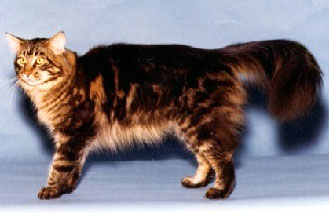 Let's take a closer look at the pedigree of these 17 clones; the kittens of Sonkey and Polly.
Let's take a closer look at the pedigree of these 17 clones; the kittens of Sonkey and Polly.Their inbreeding percentage over 4 generations is 5.47%. And the total inbreeding% is 9.38%. The top 5 foundation cats is 91%. You can see by this high percentage that a high clones percentage automatically means a high top 5 percentage. In fact, this means that the top 5 percentage is AT LEAST 91% of the clones percentage. Example: when a Maine Coon has a clone percentage of 40%, the top 5 percentage has to be at least 36,4%. The other way around you can't predict the height of the clones by looking at the top 5. The top 5 had offspring creating different lines then the clones. In theory a Maine Coon can have a top 5 % of 70% and a clone percentage of 0%. These lines weren't used as much as the lines of the clones and therefor those lines are very rare or maybe even died out.
The most counted ancestors of the clones (also called top 5 foundation):
Number 1 and 2: Bridget Katt of Heidi Ho (Bridget) and Andy Katt of Heidi Ho (Andy) are counted evenly in the pedigree and together are 64,1% of the pedigree of the clones
Number 3: Dauphin de France of Tati-Tan is 15,6% of the pedigree. The total of the top 3 together is 79,7%.
Number 4: Tatiana of Tati-Tan is 7,8% of the pedigree of the clones.
Number 5: Smokie Joe of Whittemore is good for 3,52% of the pedigree of the clones.
The total of this top 5 is 91%.
Now you understand where the top 5 foundation cats came from. The use of the clones in many breedingprograms created this top 5. You will also understand why it is not just a top 5, but the top 3 and top 2 is mentioned separately. There is a big difference between the 32% of Andy and the 3,52% of Smokie Joe.
The impact of the clones today
Because the clones were born about 40 years ago, it is not something that every current breeder takes into account. The clones are mostly no longer visible in the last 10 generations. Many breeders are therefore not aware of their impact today. The volunteers of Pawpeds have therefore developed the possibility to calculate the clones percentage for each Maine Coon. This way you can see exactly what percent of your cat's ancestors consists of the clones. To see this percentage, click on the "clone" link at the top of the family tree in Pawpeds.
The development of the clones
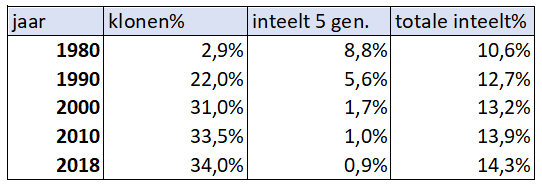
In addition, a Maine Coon with a high clones percentage automatically also has a high foundation top 5 percentage (the 5 most common foundation cats). Only a small percentage of ancestors remains where unrelated ancestors and unrelated genes can come from.
In the 80's there were many other lines that were used for breeding apart from the clones. Unfortunately, the clones were so popular in that period that many breeders sooner or later added an offspring of the clones to his or her own breeding program. Old lines with a low percentage of clones can therefore hardly be found today. The lines that do have a low clones percentage are mainly the lines to which a New Foundation Maine Coon has been added. By adding new blood to the breeding program, the clones percentage can be drastically reduced.
Why low clones is more important than low inbreeding or a low top 5
You may understand that if the current population has an average percentage in clones of 35% or higher, this will result in severe narrowing of the gene pool. The necessity is therefore high to breed with Maine Coons that are as unrelated to these 17 clones as possible.
The clones, top 5 and inbreeding percentages are linked to each other. The higher the clones percentage gets, the higher the Maine Coons parents are related to each other. As explained above, the clones have the top 5 most common ancestors behind. This top 5 will increase together with the increasing clones percentage. The average top 5 foundation percentage is 70% nowadays.
With an increasingly higher clones percentage, the average inbreeding percentage of the population also rises due to their connection to each other. It will then become increasingly difficult for a breeder to make low inbreeding combinations in the future, because there are fewer and fewer unrelated lines to be found. The table shown and discussed above shows this trend well.
The lines that are still low in the clones are often mixed too quickly and too much with lines that are high in the clones. This is often understandable from the point of view of that one breeder. A breeder wants to achieve his own breeding goals and compensate for the weaker points of the line. After all, there is a lot more availability in the population of high clones lines to find the perfect cat to complement your breeding program. However, the total population of the breed would be better served by pairing lines with low clones to other unrelated low clones lines. This increases the amount of cats that are low in the clones. This helps the total population to a higher genetic diversity. In the future this will result in more opportunities of continuing to make low inbreeding combinations. If there are more low clone lines available it will also make it possible for breeders to reach personal breeding goals and work on a higher diversity at the same time.
In summery: low inbreeding is important for short term health, but a low clone percentage helps to keep a high genetic diversity of the breed in the long run.
Low clones - breedingprogram
In the Netherlands there are very few outcross breeders (who breed with a clones percentage below 20%). Of the hundreds (400-500) Maine Coon breeders in the Netherlands, probably around 3-5% focus on outcross. The Netherlands is no exception here, because this trend is visible worldwide.
With this article I hope to create more awareness about the clones among breeders, so that more breeders want to make this a priority in their breeding program. Not everyone can or wants to work with outcross. It can't even be possible for every breeder to work with outcross, because unfortunately there are too few outcross Maine Coons available due to these trends. But every breeder can take the clones into account in his or her breeding program. Even if it is only a few percent per mating or for every new cat that you buy, every small step helps the breed to a lower clones percentage and higher genetic diversity.
By: Debbie Sprenger
You can find more interesting articles about the clones here:
- Interview with the breeder of the clones, Beth Hicks
- Article about the clones and foundation cats and their history


